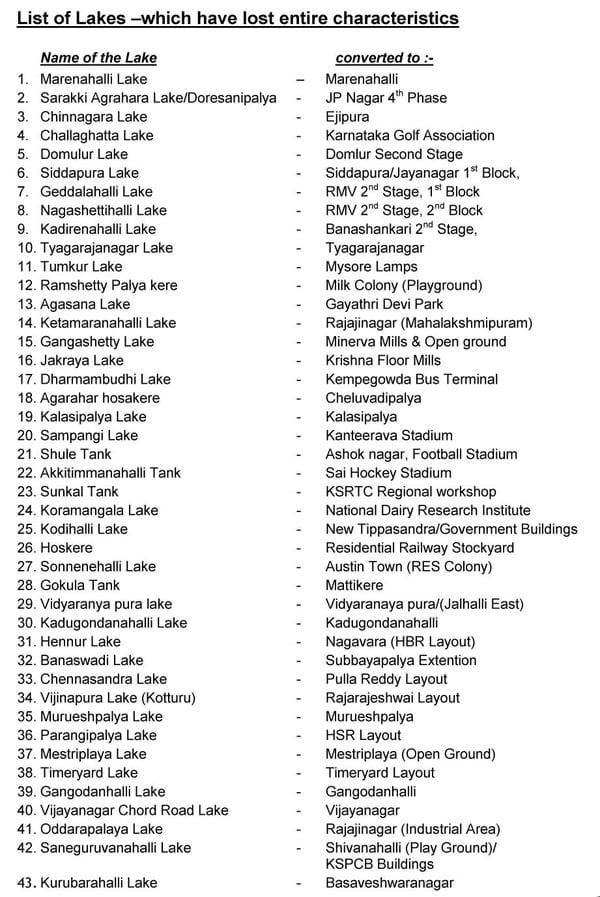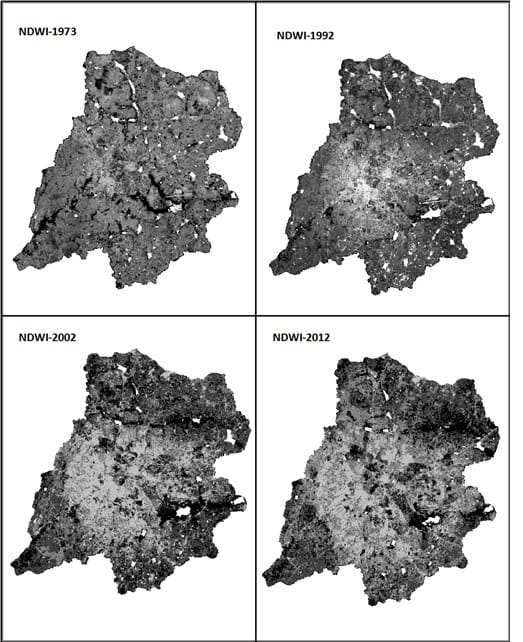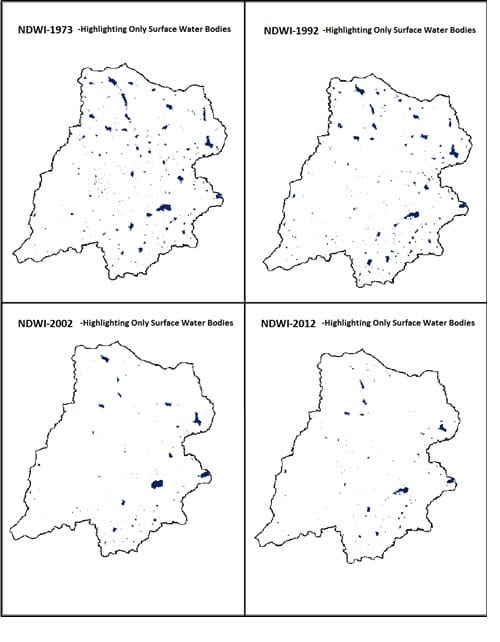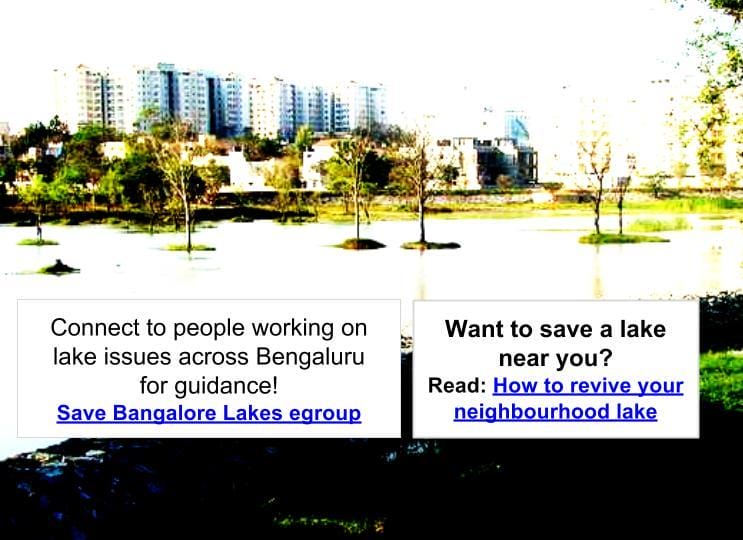The first part of this series looked at how Bengaluru expanded it self over the years, and how it has affected urban flood scenario in the city. This part explores how the surface water bodies have diminished and its effect on the flood scenario of Bengaluru city.
By now you would know that Majestic bus station was a lake once – Dharmambudhi lake. And that Bengaluru was a land of lakes once. What changed this, and why?
In a city like Bengaluru, lakes assume special importance. They provide lung space, groundwater recharge, biodiversity and recreational activities like boating and fishing. However the most important use from the context of this article is that they act as flood water mitigators. They receive rainwater through stormwater drains during the rainy season and help in keeping other areas dry.
Bengaluru district doesn’t have any live river currently. This is compensated by a number of lakes in the district. Lakes have a phenomenal significance. The entire ecological balance is maintained by nature on the basis of this factor. Hence any abnormality will prove disastrous for the entire ecosystem.
The urban development took a toll on the lakes in the city. Bangalore Gazetteer, 1981, notes that the district supports approximately 461 tanks that serve the irrigation need in the district. Most of the tanks in the district are seasonal and carry water for about six months in a year. Together, these tanks account for 54% of the total water resources of the district. They create a surface water potential of is around 12,541 hectares in the district.
Satellite data collected by BMRDA in 2001 reveals that there are 2,789 lakes in the city, which are in different stages of decay. Their sizes varied from 2 hectares to 50 hectares and covered an area of 18260.48 hectares with water.
With time, the lake areas have been transformed into residential and commercial entities, educational institutes, bus stands, stadium etc. Some lakes are now being used as dumping grounds for domestic and industrial wastes or open sewage. Here is a list of lakes which have completely lost their existence. (Source: Lake Development Authority Report: BBMP) 
According to a study conducted by a researcher, Deepa, in 1973 there were 379 tanks in two Taluks of Bangalore urban district. 138 were located in North Taluk, and 241 were in south Taluk. By 1996, they have come down to 96 in North Taluk and 150 in south Taluk. This is a decline of 35.09%. A recent study shows that the areal extent of the tanks which was 2342 ha in 1973 has reduced to 918 ha in 2007, which is a remarkable decline of 60.80%.
There were 159 water bodies spread in an area of 2003 ha in 1973 that number declined to 147 (1582 ha) in 1992, which further declined to 107 (1083 ha) in 2002, and finally there were only 93 water bodies (both small and medium size) with an area of 918 ha in the Greater Bangalore region, in 2007. (Ramachandra TV and Uttam Kumar, 2008).
Though there are differences in the numbers and extents of the tanks/lakes, all the studies on lakes accept the fact that there is a sharp decline in the number of lakes and the extent of lakes in the city. All the researches in this regard attribute this decline to the rapid urbanisation.
Studies also show that nearly 66% of lakes are sewage-fed, 14% surrounded by slums and 72% showed a loss of the catchment area. Also lake catchments were used as dumping yards for municipal solid waste, construction residue or building debris. Building debris and construction residue are being thrown into the storm water drains by the construction people working near the drain. This results in the blockage of the drains making the drains overflow during rainy seasons, which induces waterlogging in surrounding areas.
Water index study shows degradation of water bodies
To give a visual evidence to the fact that extents of the lakes in the city are diminishing, satellite images from Landsat satellite (satellite launched by NASA for Remote Sensing purpose), were studied by this researcher, for the years 1992, 2002 and 2012. The study names Normalised Differential Water Index (NDWI), which primarily suppresses all other features and highlights surface water bodies was carried out. Below are the result of the study.

So the brightest portions in the images are the water bodies in the study area. To make the features clear, further processing was done to remove all features other than water. The result is given below.

What can happen with reduced lake area?
Conversion of water bodies into urban settlements or the encroachments of the natural water bodies have resulted in the flooding. Natural drains for storm water and the natural water storage mechanism were breached. Many of the city administrators have concentrated on creating artificial lakes and ponds apart from maintaining the existing ones in good health to serve the water requirements of the city.
Bigger threats are posed by the encroachments of natural lakes. A lake naturally forms when there is a central depression and all the neighbouring areas are sloping down towards the lake. It’s a macro phenomenon. Just by closing the lake the natural slope towards the lake cannot be undone and this slope cannot be made out with naked eyes. Only a macro level survey can unveil this fact.
Such closure of the lakes will expose the new construction and surrounding areas that were not flood-prone, to floods. This is because the lake capacity has reduced vertically, so water will flow wherever there is low elevation.
There are also other negative effects that will haunt the city. They are:
- Availability of water is reduced
- Groundwater recharge does not take place
- Flora and fauna are affected
- Tourism and recreation gets affected (as we see hardly any lake in the city offers a place to walk or relax on weekend)
- Livelihood of people depending on tourism, fishing etc are affected
All this only underlines an urgent need to restore and maintain the lakes in the city to make it liveable.
LDA has made some efforts to rejuvenate several lakes in the city along with detailed project reports. However, being the toothless body it is, LDA’s efforts have not been very useful in this regard. To read what the LDA does and its scope, click here.
Now, can imagine Majestic being re-converted to a lake? It has become such an integral part of the city’s commute, Dharmambudhi lake is lost forever. Though whatever development that happened so far cannot be undone, future developments can be planned well. However some relevant changes to the existing land use and the elevation profile in the areas which are already developed can help minimise the damages and losses during floods.
What changes? Let us explore them in the last part of the series.
<!–
–>

Related Articles
Here’s how Bengaluru is becoming increasingly flood-prone
Summer showers flood National Games Village
Why Bengaluru is not immune to floods: It’s all about land (and money)
Well we can’t get back the lakes. Unless you want to face a riot.
There is one thing you can do to prevent flooding.
Plant more trees with DEEP ROOTS. Not just the greenery. Their roots act as micro pipes which absorb or draw water into the ground.
No point planting gulmohars and useless tres. Their roots barely go 3 meters.
I don’t know which ones are correct. Horticulture folks can advise on selection.
Hi,
I agree with you. It is planned to give a detailed solutions on the ways to to reduce flood vulnerability in the last part of the series.
The dharmambudi lake on which Majestic bus stand is built now, was actually a man made tank (reference: Mysore gazetteer). It supplied drinking water to the surroundings for many many years. I don’t know who built it though.
The other big water body those days was Millers Tank. There is a drawing in Wikipedia. It’s perimeter is now queens road, thimmaiah road, Cunningham road and of course Millers tank bund road.
You are right.
There are several man made lakes in Bangalore primarily to address the water requirements of the city. Encroaching a man made lake would not affect the city as much as encroaching a natural lake. Having said that, we must keep in mind that, artificial ponds are also not built just like that. There are a lot of scientific considerations while doing so. Recharge of these lakes are primarily due to the surface runoff. So they are build generally in the course of a drain before water reaches the major tank. With the same land use existed at the time the lake was made, probably we can say, there would be no flood unless the major lake in the downstream floods. But with the changes land use, it is not possible ti give that statement. Even encroachment of this small pond will result in localized flooding.